Contents
- Description, types and varieties of cedar
- Is it possible to plant cedar
- Features of growing cedar from seeds at home
- How to germinate pine nuts at home
- Planting and caring for cedar in the open field
- Diseases and pests
- In autumn, the needles of the cedar turned yellow: what is it
- How to distinguish a cedar seedling from a pine
- Tips from experienced gardeners
- Conclusion
Cedar (Cedrus) is a three-species genus of coniferous trees belonging to the Pine family. The natural range of this culture covers the mountainous Mediterranean and the western part of the Himalayas. Germinating cedar seeds at home is not particularly difficult and can be an alternative to buying expensive seedlings. You just need to get the seeds and be patient.
Contrary to popular belief, cedar seeds are inedible. They cannot be bought in a supermarket or on the market. Under the name pine nuts, the seeds of Siberian cedar pine are sold everywhere, which is with Cedrus in the same degree of relationship as, say, hawthorn and pear.
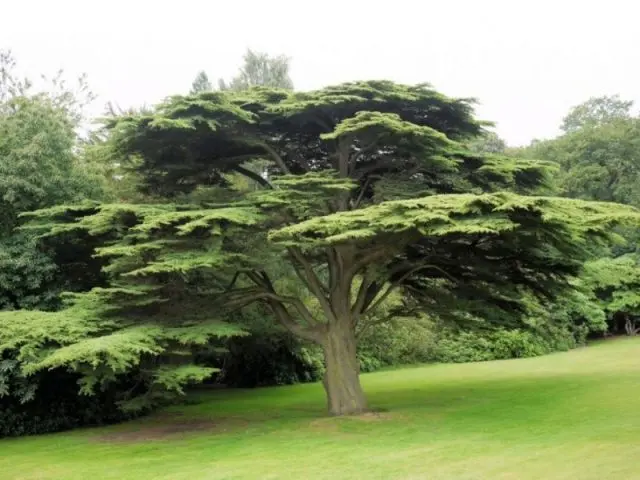
Description, types and varieties of cedar
Cedar is a monoecious evergreen coniferous plant. At a young age, its spreading crown has a pyramidal shape, in old trees it becomes umbrella-shaped.
The bark is dark gray, scaly, cracking. The root system is superficial, so a single tree can be knocked down by a strong wind.
The needles of the cedar are hard prickly needles with three or four edges, blue-green or silver-gray. They are collected in bunches of 30-40 pieces and are arranged spirally or singly on shortened branches. Each needle lives from 3 to 6 years.
Cones are located throughout the crown of the tree and bloom in autumn. Women’s can be recognized by size: their length is 5-10 cm, width – 4-6 cm, men’s are much smaller and surrounded by needles. Seeds on the tree ripen 2-3 years after fertilization and crumble. They are resinous triangles with a 12-18 mm long wing.
An old tree can reach a height of 60 m with a crown width of 3 m. It lives up to a thousand years or more (according to some sources – up to 3 thousand). The genus consists of three species. True, some taxonomists distinguish the Cypriot Shortconiferous from the Lebanese Cedar as a separate species.
Of course, this culture has high decorative qualities. But to grow a tree on the site, which, even after many years, will reach 60 m, is at least unreasonable. Now varieties have been created that are short and beautiful, but, unfortunately, do not grow even in frost resistance zone 5. Some of them can be planted in the Rostov region, many in the south of the Krasnodar Territory.
Cedar Atlas
Very light-loving species, living up to 800 years. The crown of the tree is cone-shaped, height – 40-50 m. The branches are densely covered with bluish-green or silver needles 2,5 cm long gathered in bunches. Cones ripen 3 years after pollination.
Atlas cedar does not like calcareous soils, but tolerates urban conditions well. The tree is widely used in park plantings in Eastern Transcaucasia, on the Black Sea coast of the Crimea and the Caucasus.
Popular varieties of Atlas cedar are highly decorative and are intended for cultivation in frost resistance zones from 6 to 9:
- Glauca (Glauca) – a branchy tree about 20 m high with grayish-blue needles;
- The fastiga (Fastigiata) – differs in bluish needles, a columnar crown, narrower than in other varieties and species of Atlas cedar, branches raised up;
- Glauca Pendula (Glauca Pendula) – weeping form up to 6 m high with bluish needles.

Himalayan cedar
It tolerates shading better than others, but is not well adapted to survival in urban conditions. It lives for about a thousand years, grows up to 50 m, while the trunk diameter can reach 3 m. In an adult cedar, the crown is cone-shaped, horizontal branches are densely covered with light gray-green needles 25-50 mm long, collected in bunches.
The tree tolerates a haircut well, blooms in the second half of autumn. Seeds ripen in a year and a half and crumble, they have the best germination. The Himalayan cedar gained particular popularity due to the fact that the crown of each instance has an original shape.
The species is undemanding to soils, but with a high lime content, it suffers from chlorosis and grows slowly. In the southern regions of Our Country, varieties can be grown that can winter in zone 6:
- Karl Fuchs (Karl Fuchs) – the most winter-hardy variety with a conical crown, young needles are almost blue in color, turn green with age;
- Golden Horizon (Golden Horizon) has a wide flat crown, reaches 4,5 m by the age of ten, greenish-yellow needles in the sun, gray-green in the shade;
- Repandens (Repandens) – a weeping tree with gray-green needles;
- Silver Mist (Silver Mist) – a dwarf form with silver-white needles, by the age of 15 growing up to 60 cm with a width of 1 m;
- Divine Blue (Divinely Blue) grows no higher than 2,5 m, has a narrow conical crown and gray-green needles.
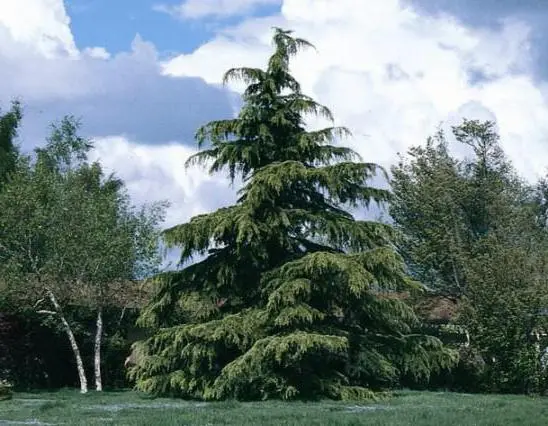
Cedar Lebanese
The most frost-resistant and photophilous of the species. It grows up to 40 m, it is distinguished by widely spread, storey-shaped branches, covered with hard bluish-green or dark green needles gathered in bunches. The crown of a young tree is pyramidal, an adult tree is prostrate.
This species is not suitable for growing in urban conditions, but can even tolerate calcareous soils. Lives for over a thousand years. It has a durable light wood with a pleasant smell and devoid of resin passages. It is widely used in the park culture of Eastern Transcaucasia, Central Asia, the Black Sea coast of Crimea and the Caucasus.
Varieties that grow well in the sixth zone of frost resistance:
- Glauca (Glauca) – a tree with a weeping asymmetrical crown and gray-green needles;
- Nana (Nana) – a dwarf form, which is a versatile bush, reaching 10 m by the age of 0,9;
- Beacon Hill (Beacon Hill) – a tree with a narrow conical crown, weeping branches and cracking bark;
- Sargents (Sargentii) can grow in partial shade, has a weeping crown, reaches 10 m by the age of 1;
- Turkish (var. Stenocoma) – not a variety, but a form of Lebanese cedar popular among landscape designers with a pyramidal crown, upward branches and growth up to 3 m, can grow in frost resistance zone 5.
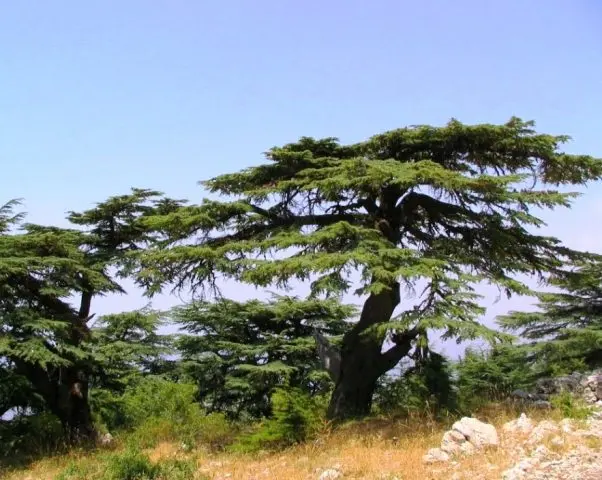
Is it possible to plant cedar
It is quite possible to grow a cedar from a nut at home. You just need to first find seeds, moreover, of acceptable quality – they ripen 2-3 years after pollination. In addition, not what the gardener ordered by mail may come; when searching for planting material, it is better to rely on personal contacts.
Even if you successfully germinate the seeds and bring the seedlings to the size appropriate for moving into the ground, planting and caring for cedar in the Moscow region is impossible. The tree is quite thermophilic, even the most frost-resistant varieties will withstand a short-term drop in temperature only to -30 ° C.
Cedar grown from seeds at home does not inherit varietal characteristics. So you can plant a tree only in the southernmost regions, in 7-9 frost resistance zones. Most likely, over time, it will reach a size of 30-60 m. Varietal trees propagated by grafting, some of which winter in zone 6, may be low, 2-6 m. There are even those that do not exceed 80 cm in adulthood.
But planting and growing in the country Siberian Cedar, which is a species of the Pine genus, is quite possible. It is hardy and lives up to its name – it can survive in the harshest climates without shelter. In addition, the Siberian Cedar has low-growing, highly decorative varieties that make it an indispensable crop in the design of plots located in the North-West.
Features of growing cedar from seeds at home
Before you start germinating cedar seeds, you need to think about the purpose for which this is being done. If it’s just out of curiosity, no problem. But when a gardener wants to germinate a pine nut in order to move the tree to the garden or leave it at home, one should think about the advisability of such an operation:
- From the seed of a varietal cedar, which is not very tall, but resistant to low temperatures, a species tree will grow. Over time, it will reach a huge size and will not differ in frost resistance.
- Growing cedar on a balcony or in a room, as enthusiasts advise, is actually very difficult. The tree needs differences between night and day temperatures, high humidity.
- In general, no matter what the “experts” say, it is very difficult to grow conifers indoors. At home, it is almost impossible for them to create suitable conditions. As a houseplant, you can plant araucaria. All. The rest of the trees will have to be messed with, like with small children. And cedar is generally not an easy crop to grow, even in a suitable climate.
- Even if the gardener lives on the Black Sea coast, the question arises: does he have enough space on the site for species cedar? Otherwise, it may happen that only one tree will grow in the yard of the heirs.
- In addition, cedar is resistant to wind. Simply put, a tree has a shallow root system, if it grows alone, a strong wind can knock it down. Is there room on the plot for a grove?
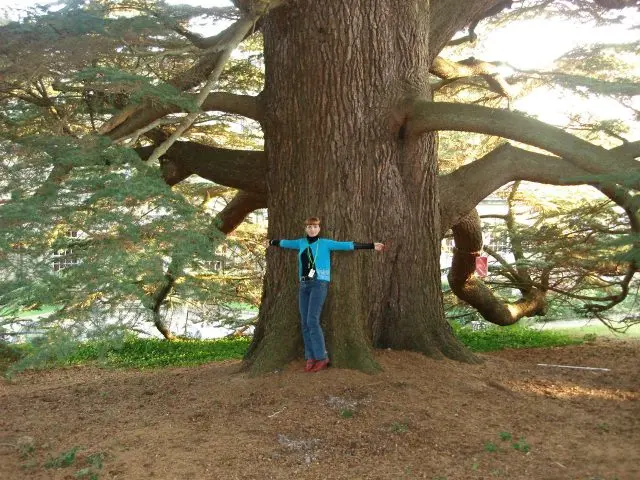
What else should a gardener know who still decides to grow cedars from seeds:
- before landing in the ground, it is easier to bring the Himalayan, Atlas and Lebanese cedar, it is better to leave it to specialists;
- the shell of cedar seeds is thin, unlike other conifers;
- culture during germination does not need stratification of seeds;
- if the seeds have germinated, even among gardeners who easily breed closely related pines, the seedlings may die due to the slightest mistake or inattention;
- Himalayan cedar cones ripen in a year and a half and open on their own;
- in order to “get” the seeds of the Lebanese cedar, the cone is soaked and dried several times, 3 years pass from the moment of pollination to ripeness;
- the germination of seeds of the Lebanese cedar is 20 years, the Himalayan – a few months.
How to germinate pine nuts at home
Germination of cedar seeds in flower pots does not make sense – if they sprout, they will quickly die due to the inability to create the proper conditions for the plant. Those who claim otherwise should try it themselves. Even if someone’s seedling survives, it will be a rare exception. And in the 2-3 years that must pass before landing in the ground, everything can happen.
To germinate seeds indoors, special conditions are needed:
- temperature fluctuations between day and night;
- constant high humidity;
- low positive (from 4 to 8 ° C) temperature in winter;
- bright diffused light;
- a constant outflow of moisture from the soil, and just taking a pot with holes and laying a drainage layer is not enough, even a short-term stagnation of water will destroy the sprouts.
Seeds need to be planted on the street or in specially adapted premises that are available for farms engaged in the cultivation of coniferous trees. They can be equipped by an amateur, but this requires financial and labor costs, a separate room, special equipment. At least for year-round maintenance of the necessary regulated humidity and temperature, forced ventilation.
On the street, you can equip a cold greenhouse in which the seedlings will develop and be kept until planting in the ground. There you can also propagate other coniferous trees both by seeds and cuttings.
Selection and preparation of seeds
It is better to collect Himalayan cedar cones on your own – the seeds quickly lose their germination capacity. They should grow quickly. Seeds of the Lebanese cedar can be bought, as they can sprout even 20 years after harvest. It is important that the cones ripen on the tree.
In real cedar, the seeds are covered with a soft shell; it is not necessary to cook them for sowing. But pre-soaking increases germination, which is 50% for Lebanese and 70% for Himalayan.
Before planting, the seeds are dipped for 20 minutes in a pink solution of potassium permanganate, then left in warm water for 1-2 days. The planting material that has risen to the surface is thrown away – it has definitely lost its germination capacity.
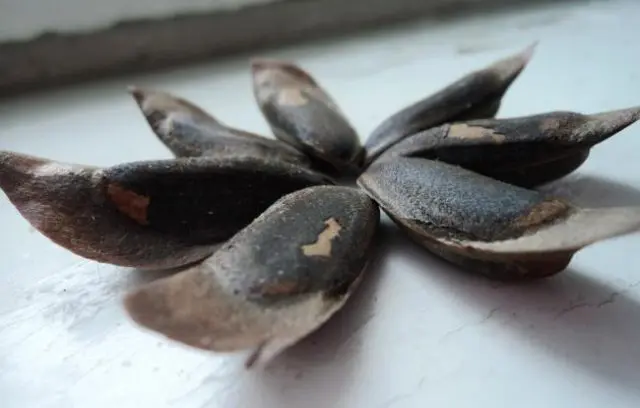
Stratification of cedar seeds at home
In fact, true cedar seeds do not need stratification. If you spend it for 60-90 days, as for pine, the planting material will definitely die. But short-term keeping in a moist substrate at a temperature of 3-5 ° C will be useful, but only if the seeds are sown in the spring.
Coarse-grained sand is washed, disinfected with potassium permanganate and calcined in the oven. You can replace it with perlite mixed with sour peat. It is enough to soak them in a weak solution of potassium permanganate and rinse well.
Such recommendations are given when germinating almost all large seeds or cuttings of coniferous trees. Most amateur gardeners ignore them, and often get quality seedlings safely. With real cedar, this number will not work – an infected substrate can destroy seedlings at any stage.
Seeds are mixed with three times the volume of wet sand or perlite, and placed in a pre-prepared container. For these purposes, you can take a plastic puddle with holes in the bottom and on the sides.
The container is placed on rails to provide air access and placed in the lower section of the refrigerator. You can use a cool room with a temperature of 3-5 ° C.
Maintaining a moisture balance is very important – the substrate should not be dry or too wet. A lack of moisture will prevent the seeds from hatching, and an excess will destroy them. This requirement is especially important when germinating the Lebanese cedar.
Stratification should not take longer than 2 weeks. Seeds should be inspected every day – they can hatch in 2-3 days, and then they should be sown immediately. If left unattended, sprouts can rot or break when planted.
Growing cedar at home after stratification
In autumn, seeds are sown in a cold greenhouse without any stratification. If you let the sprouts hatch, and only then put them in the ground, in winter, even warm, they will die.
Of course, you can plant the seeds in containers and put them in the house. But they rise quickly, and the conditions of detention have already been considered – it is impossible to create them in an unsuitable room.
A cold greenhouse is the best solution for growing cedar from seeds. The substrate should be light, consisting of a mixture of sand, acid peat and leaf humus. Seeds are sown to a depth of 1,5-2 cm rather tightly to each other – they are not afraid of a thickened planting.
Seedlings are regularly watered, not allowing the soil to dry out even for a short time. Overwatering will cause a disease with a black leg, due to which most of the seedlings die. No loosening can be carried out – this will also “thin out” seedlings. If the substrate has been prepared correctly, it is already sufficiently permeable to water and air.

You need to start feeding the seedlings only when they get stronger – the leaf humus contains a certain amount of nutrients, for the first time they will be enough. Untimely fertilizer can not only reduce the number of small trees, but also destroy them completely. In summer, seedlings need to be shaded, in winter, with a sharp decrease in temperature, insulate the greenhouse, and when warming, remove the shelter.
About a year after germination, cedars dive into small plastic containers with a drainage layer, holes in the bottom and sides. Seedlings are taken out of the ground with a spoon in order to less damage the root and planted at the same depth as before. Containers are watered and immediately dropped in a cold greenhouse. Transplanting is best done in the fall.
Trees are transplanted to a permanent place no earlier than 2-3 years after germination. If the plants are for sale, they can be transferred to large containers as needed and kept in them for up to 9 years.
Planting and caring for cedar in the open field
In Our Country, growing cedars is more difficult than other conifers. They need a strictly controlled water regime. In addition, areas suitable for cultivation are located along the Black Sea coast, and trees do not tolerate strong sea winds.
How to plant a cedar
Planting a tree itself is not particularly difficult. It is important to choose a suitable place and follow the landing rules.
Terms of planting
Cedars should be planted in open ground in a strictly defined period. Only in this way is there a guarantee that they will take root well. Earthworks begin in the fall, after most of the deciduous trees fly around, continue all winter. Transplantation of cedars ends in the spring, before bud break.
Preparation of planting material
Seedlings at the age of 6-8 years take root best of all. Cedar grown in a container is watered 2-3 days before planting. When transplanting a tree to another place, it is dug out with an earthen clod with a diameter of at least 20 cm, wrapped when carrying or moving from the nursery to the site with a film or a damp cloth.
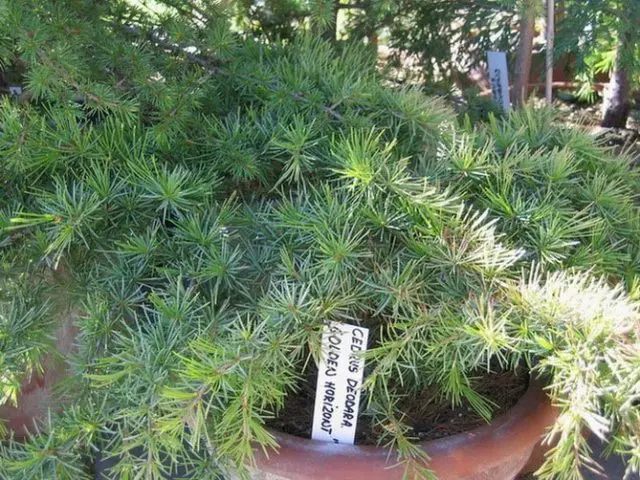
Soil for planting cedar
All cedars are photophilous, only the Himalayan cedar can tolerate a slight shading. They prefer to grow on loose, fertile loam, but will tolerate any sufficiently permeable soil that is not prone to clogging, except calcareous.
At the place where the tree is planted, groundwater should not come closer to the surface than 1,5 m. This is enough for varietal plants, species will also not suffer – the culture has superficial roots, spread more in breadth than in depth.
A landing pit for planting a tree is dripped a third more than the volume of a root or earthen coma. You need to prepare it in advance.
On loose fertile sandy loams and loams that do not contain a large amount of lime, sour peat, leaf humus, ash, and special fertilizers for conifers are added to the soil. It is useful to bring at least some bedding from a pine or spruce forest to add to the planting mix. Leaf humus and sand are added to dense soil. Lime soils are brought into proper condition with the help of large doses of acidic (moor) peat.
At what distance to plant cedars
Cedars are planted as part of large and small landscape groups. A single tree looks beautiful, but such an arrangement is possible in a place protected from strong gusty winds. The distance between cedars during planting, even for species plants, is acceptable at 3 m – they are not afraid of dense plantings and will not suffer when they grow up.
But the tree is not only decorative bark and crown. Cones are very beautiful, especially in Lebanese cedar. The more light a tree receives, the sooner it starts to bloom. Even with a loose fit, the first buds appear after 18 years.
Rules of landing
The pre-dug planting hole is completely filled with water. Waiting for it to soak in. Coming to boarding:
- A nutrient substrate is poured to the bottom so that the horse neck after planting a tree and watering remains at ground level.
- A cedar seedling is placed in the center.
- The cedar is covered with prepared soil, gently tamping as the hole fills up.
- Check the position of the root neck.
- Water the tree thoroughly.
- The trunk circle is mulched with sour peat or coniferous litter.
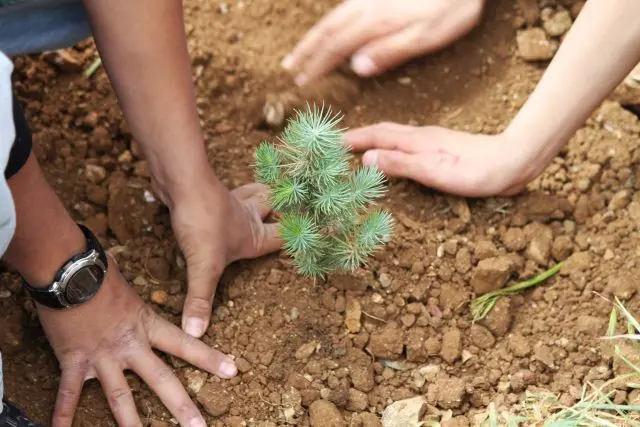
Watering and top dressing
Even adult cedar, unlike other coniferous crops, is especially demanding on watering. The soil should not dry out, but stagnation of water at the roots is unacceptable.
The need for moisture must be determined independently. The frequency of irrigation depends on the weather, the composition and permeability of the soil, the proximity of groundwater.
Top dressing can only be used mineral – infusions of mullein, bird droppings or grass can be harmful. For cedar, it is better to buy special fertilizers designed for coniferous trees and lawns. On sale there are dressings designed for different seasons. They must be used strictly according to the instructions and in accordance with the seasons.
An important role in the nutrition of cedar is played by foliar top dressing. At least once a month (not more than 1 time in 14 days), the tree is sprayed with fertilizers throughout the growing season. It is best to use a complex of chelates – there are all the nutrients that are well absorbed through the needles. Additionally, a portion of magnesium sulfate is added to the balloon.
Pruning cedar
By and large, only sanitary pruning is needed in the country. It is carried out before the growth of new shoots in the spring. The crown of the cedar without any additional measures is attractive. But sometimes the trees interfere with each other’s growth or block the view of something very attractive, hidden in the depths of the garden. Cedar can be safely cut at the beginning of the season. For a cardinal correction, it is better to choose September.
Sometimes the owners want to create a topiary shape or cut the tree so that it resembles a nivaki. Such a haircut should also be done in September, when the heat subsides, but before the end of the season there will be enough time for the cedar to heal the wounds and recover.
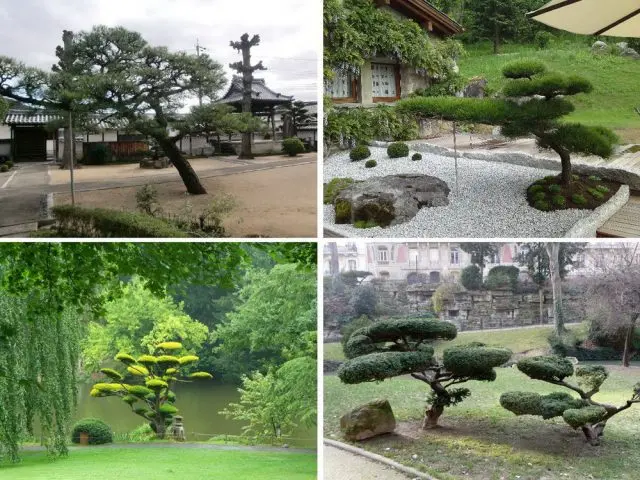
Preparation for winter
Real cedar grows only in the southern regions. A young tree needs shelter in the first year after planting. It is wrapped with white spandbond or agrofibre, and secured with twine.
Diseases and pests
Cedar does not belong to crops that are rarely affected by diseases, and it has more than 130 pests, to combat which it is necessary to use folk and chemical remedies. A well-groomed tree rarely gets sick and is affected by pests. So the right agricultural technique in itself is the best protection.
Among the pests that affect the cedar, it is worth highlighting:
- cone fire;
- spruce codling moth;
- cone moth;
- spruce sawfly;
- red pine sawfly.
Of the cedar diseases, the most dangerous for the tree are:
- variegated red rot;
- brown central rot;
- brown prismatic rot;
- rust.
Separately, I would like to note the fungi that parasitize on cedars and serve as the cause of many tree diseases:
- pine sponge;
- root sponge;
- tinder of Schweinitz.
In autumn, the needles of the cedar turned yellow: what is it
Cedar needles may turn yellow before falling off. If the needles live on a tree for 3 to 6 years, this is normal. Then they naturally crumble. You should sound the alarm if a young 1-2-year growth has changed color.
First of all, carefully examine the needles and branches of the tree with a magnifying glass. If there are no signs of pest damage, and young cedar needles are yellow, you need to look for the cause. It could be:
- The first sign of overflow or stagnation of moisture at the roots.
- Gardeners can buy damaged or even dead trees. But the conifers fade slowly, and the needles often turn yellow after the plant is planted in the ground.
- Sunburn of a tree in winter. The snow that fell in the southern regions can work like a lens, and the needles will suffer.
- Insufficient watering – cedar is sensitive to lack of moisture.
- Chlorosis. Lime soil and micronutrient deficiencies can cause yellowing of cedar needles. Nutrients are absorbed faster through needles and leaves, and chelates – only with foliar processing.
If watering is adjusted, spraying the needles with a solution of chelates did not help, and the cedar has been growing on the site for a long time, you should think about fungal and viral diseases and treat the tree with fungicides.
How to distinguish a cedar seedling from a pine
In nature, there are many “cedars” that have nothing to do with the genus Cedrus. The culture should not be confused with such coniferous and deciduous trees, relying only on the name:
- Pine Cedar Stlanikova, Korean, Siberian and European, the seeds of which are eaten and are called pine nuts;
- Canadian Cedars Red and White, belonging to the genus Thuya;
- Oriental Red Cedar, as Juniper Virginia is sometimes called;
- Yellow Alaskan Cedar – Nootkan Cypress;
- Fragrant Cedar – an evergreen deciduous Gware tree growing in Africa;
- Spanish Cedar – Cedrela Dusto, also not a conifer.
In practice, real cedar is confused with cedar pines. But they are easy to distinguish in just two ways:
- The needles of real cedar are short, about 2,5 cm long. Only in the Himalayan they can grow up to 5 cm. Cedar needles are collected in whorls of 40 pieces. In the cedar pine, the needles reach a length of 6-20 cm, and there are only 5 of them in a bunch.
- The bumps are very different. This is clearly visible in the photo.
Cone and needles of Lebanese cedar
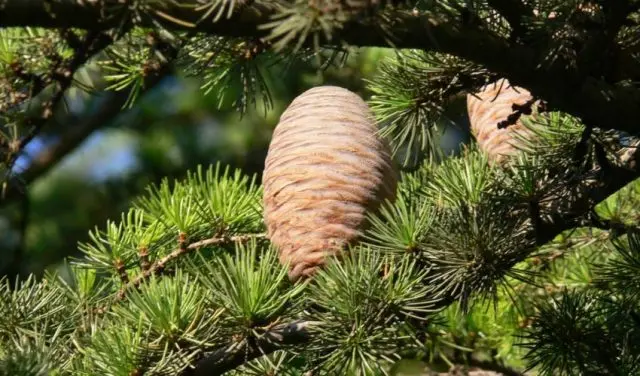
Cone and needles of Siberian cedar pine
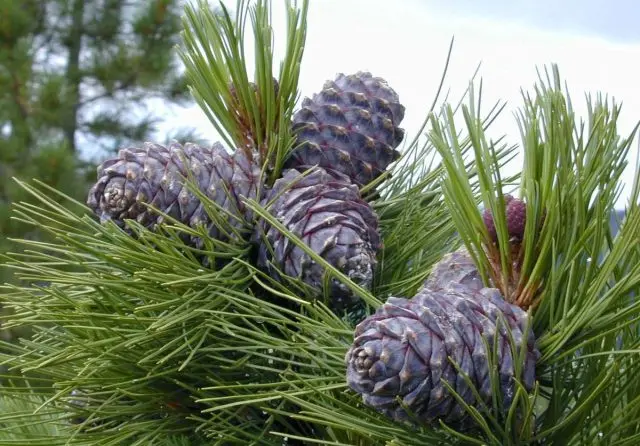
Tips from experienced gardeners
What else do you need to know about real cedars and what is worth re-focusing on?
- The first and main advice: you should not plant cedars in frost resistance zones below 6. When choosing a variety, you need to pay attention to whether it can survive on the site in winter.
- Species plants should not be placed in small private estates, even on the Black Sea coast – over time, the trees will become huge.
- Those who plant a crop in order to obtain edible nuts can forget about it – the seeds of a real cedar should not be eaten.
- When growing conifers, special attention should be paid to watering – almost all problems with a tree arise due to drying out or jamming of the soil.
- Cedar is prone to chlorosis, and not only on calcareous soils. Treatment of the crown with chelates should become a familiar procedure in seasonal care.
- Cedar requires increased attention of the owners. It is not a culture for the lazy or the busy. If the gardener does not have time to mess with the tree, it is better to choose another conifer.
- When placing a cedar, it is better to plant it closer to the recreation area. The phytoncidal properties of the tree are high even in comparison with other conifers.
Conclusion
Germinating cedar seeds at home is not an easy task. Whether it is worth doing this, the gardener must decide on his own, focusing on the presence or absence of free time and the climate of the region in which the tree is supposed to be planted. In any case, even from self-collected seeds of low varieties, a huge plant will grow.









